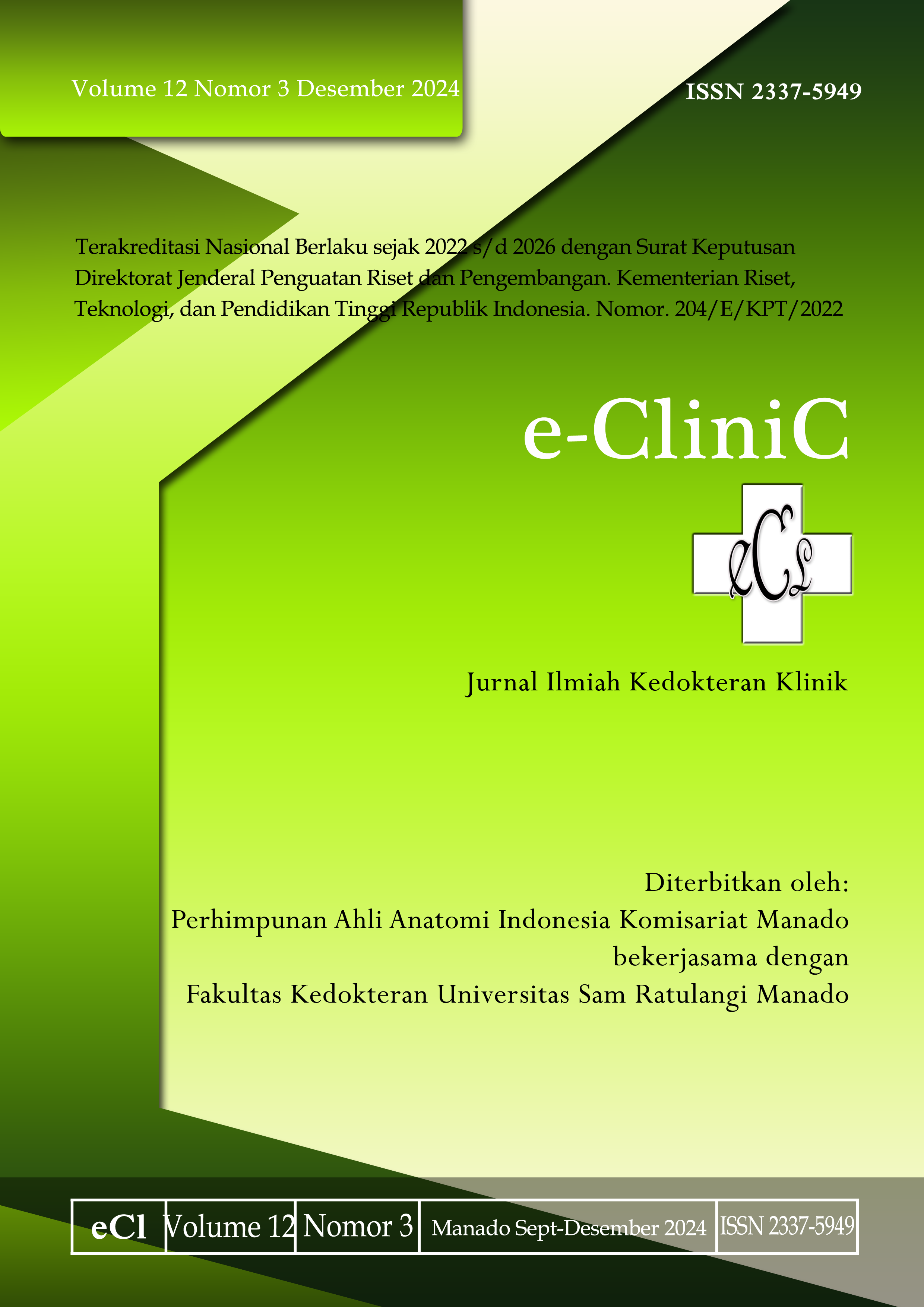Long-Term Outcomes of Cataract Surgery: Analysis of Visual Acuity and Intraocular Pressure in a Tertiary Care Center
DOI:
https://doi.org/10.35790/ecl.v12i3.58044Abstract
Abstract: Posterior capsule opacity (PCO) is a common complication following cataract surgery, caused by the proliferation of residual lens epithelial cells. This study aimed to evaluate the long-term effects of Nd:YAG laser capsulotomy on intraocular pressure (IOP) and visual acuity in PCO patients. This was a retrospective descriptive study. Samples were 24 patients diagnosed with PCO who underwent Nd:YAG laser capsulotomy at Prof. Dr. R. D. Kandou Hospital, Manado, from January 1, 2022, to January 1, 2024. The study recorded pre- and post-procedure IOP and best-corrected visual acuity (BCVA) data. Descriptive analysis, including paired t-tests, was used to assess changes in IOP and BCVA over an average follow-up period of 19.2 months. The results showed a statistically significant improvement in BCVA (p=0.000), with mean values improving from 0.72 to 0.27 LogMAR. A significant reduction in IOP was also observed (p=0.015), with long-term IOP remaining stable. A weak correlation was found between follow-up duration and IOP variation (p=0.02). In conclusion, Nd:YAG laser capsulotomy significantly improves visual acuity and stabilizes intraocular pressure in the long term for PCO patients, suggesting its effectiveness in managing post-cataract surgery complications.
Keywords: posterior capsule opacity; Nd:YAG laser capsulotomy; intraocular pressure; visual acuity; cataract surgery
References
Konopińska J, Młynarczyk M, Dmuchowska DA, Obuchowska I. Posterior capsule opacification: a review of experimental studies. J Clin Med. 2021;10(13):2847. Doi: 10.3390/jcm10132847
Raj SM, Vasavada AR, Johar SR, Vasavada VA, Vasavada VA. Post-operative capsular opacification: a review. Int J Biomed Sci. 2007;3(4):237-50. Available from: https://pubmed.ncbi.nlm.nih.gov/23675049/
Ursell PG, Dhariwal M, O’Boyle D, Khan J, Venerus A. 5 year incidence of YAG capsulotomy and PCO after cataract surgery with single-piece monofocal intraocular lenses: a real-world evidence study of 20,763 eyes. Eye. 2020;34(5):960-8. Doi: 10.1038/s41433-019-0630-9
Bhangra JS. A review of posterior capsular opacification. CRO (Clinical & Refractive Optometry) Journal. 2023. Doi: https://doi.org/10.57204/001c.82056
Georgalas I, Petrou P, Kalantzis G, Papaconstantinou D, Koutsandrea C, Ladas I. Nd: YAG capsulotomy for posterior capsule opacification after combined clear corneal phacoemulsification and vitrectomy. Ther Clin Risk Manag. 2009;5(1):133-71. Doi: 10.2147/tcrm.s4754
Karahan E, Er D, Kaynak S. An Overview of Nd:YAG Laser Capsulotomy. Med Hypothesis Discov Innov Ophthalmol. 2014;3(2):45-50.
Parajuli A, Joshi P, Subedi P, Pradhan C. Effect of Nd: YAG laser posterior capsulotomy on intraocular pressure, refraction, anterior chamber depth, and macular thickness. Clinical Ophthalmology. 2019;13:945-52. Doi: 10.2147/OPTH.S203677
Ge J, Wand M, Chiang R, Paranhos A, Shields MB. Long-term effect of Nd: YAG laser posterior capsulotomy on intraocular pressure. Arch Ophthalmol. 2000;118(10):1334-7. Doi: 10.1001/archopht.118.10.1334
Mehmood F, Mazhar SA, Farooq N, Zahid S, Masood H, Iqbal N. Effect of Nd: YAG Laser Posterior Capsulotomy on Intraocular Pressure. Pakistan Journal of Medical & Health. 2022;16(1):109-10. Doi: https://doi.org/10.53350/pjmhs22161109
Prokofyeva E, Wegener A, Zrenner E. Cataract prevalence and prevention in Europe: a literature review. Acta Ophthalmologica. 2013;91(5):395-405. Doi: https://doi.org/10.1111/j.1755-3768.2012.02444.x
Truscott RJ, Friedrich MG. The etiology of human age-related cataract. Proteins don't last forever. Biochim Biophys Acta. 2016;1860(1PtB):192-8. Doi: 10.1016/j.bbagen.2015.08.016
Bell SJ, Oluonye N, Harding P, Moosajee M. Congenital cataract: a guide to genetic and clinical management. Therapeutic Advances in Rare Disease. 2020;1:2633004020938061. Doi: 10.1177/2633004020938061
Ge J, Wand M, Chiang R, Paranhos A, Shields MB. Long-term effect of Nd:YAG laser posterior capsulotomy on intraocular pressure. Arch Ophthalmol. 2000;118(10):1334-7. Doi: https://doi.org/10.1001/archopht. 118.10.1334
Kaur P, Gusain P, Mohan C, Bedi J. Effect of Nd: YAG laser capsulotomy on IOP rise and its variation with energy used. Ind J Clin Exp Ophthalmol. 2018;4(3):396-400. Doi: 10.18231/2395-1451.2018.0086
Ota A, Ota I, Kachi S, Miyake G, Haga F, Miyake K, et al. Factors associated with reclosure of posterior capsule aperture by flat opacifications with pearls after Nd:YAG laser posterior capsulotomy. Diseases. 2023;11(2):82. Doi: 10.3390/diseases11020082
Teshigawara T, Akaishi M, Mizuki Y, Takeuchi M, Hata S, Meguro A, et al. Modified technique of setting capsulotomy thickness in reducing capsulotomy-related complications during femtosecond laser-assisted cataract surgery: a prospective, comparative cohort study. Ophthalmology and Therapy. 2023;12(5):2621-30. Doi: https://doi.org/10.1007/s40123-023-00770-5
Jain S, Chandravanshi SL, Jain G, Tirkey E, Jain SC. Effect of ND: YAG laser capsulotomy in pseudophakic eyes with special reference to IOP changes. Journal of Evolution of Medical and Dental Sciences. 2014;3(55):12627-35. Doi: 10.14260/jemds/2014/3672
El Kady I, Eliwa E-SM, Ibrahim M. Refraction and intraocular pressure changes after YAG laser posterior capsulotomy in posterior capsular opacification. Al-Azhar International Medical Journal. 2022;3(5):75-82. Doi: https://doi.org/10.21608/aimj.2022.113898.1769
Shrivastava A, Singh K. The impact of cataract surgery on glaucoma care. Curr Opin Ophthalmol. 2014;25(1):19-25. Doi: 10.1097/icu.0000000000000010.
Magno BV, Datiles MB, Lasa MSM, Fajardo MRQ, Caruso RC, Kaiser-Kupfer MI. Evaluation of visual function following Neodymium:YAG laser posterior capsulotomy. Ophthalmology. 1997;104(8):1287-93. Doi: https://doi.org/10.1016/S0161-6420(97)30146-8
Moshirfar M, Basharat NF, Seitz TS, Peterson CM, Stapley SR, Ziari M, et al. Refractive changes after Nd: YAG capsulotomy in pseudophakic eyes. Clin Ophthalmol. 2023;17:135-43. Doi: 10.2147/OPTH.S395605
Downloads
Published
How to Cite
Issue
Section
License
Copyright (c) 2024 Ade J. Nursalim, Vera Sumual, Andrew Chietra, Ardelia Emily, Richardo Rusli

This work is licensed under a Creative Commons Attribution-NonCommercial 4.0 International License.
COPYRIGHT
Authors who publish with this journal agree to the following terms:
Authors hold their copyright and grant this journal the privilege of first publication, with the work simultaneously licensed under a Creative Commons Attribution License that permits others to impart the work with an acknowledgment of the work's origin and initial publication by this journal.
Authors can enter into separate or additional contractual arrangements for the non-exclusive distribution of the journal's published version of the work (for example, post it to an institutional repository or publish it in a book), with an acknowledgment of its underlying publication in this journal.
Authors are permitted and encouraged to post their work online (for example, in institutional repositories or on their website) as it can lead to productive exchanges, as well as earlier and greater citation of the published work (See The Effect of Open Access).







